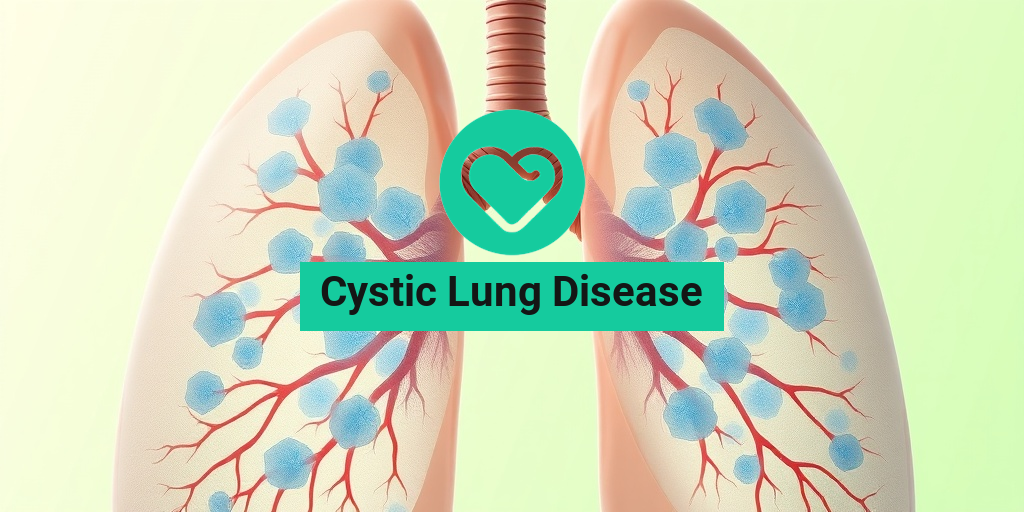What Is Cystic Lung Disease?
Cystic lung disease is a term that encompasses a variety of lung conditions characterized by the presence of cysts or cyst-like structures within the lung tissue. These cysts can vary in size and number, leading to a range of respiratory issues. The condition can be congenital (present at birth) or acquired later in life due to various factors, including infections, inflammation, or genetic disorders.
Types of Cystic Lung Disease
There are several types of cystic lung diseases, each with distinct characteristics and underlying causes. Some of the most common include:
- Cystic Fibrosis: A genetic disorder that affects the lungs and digestive system, leading to the production of thick mucus that can obstruct airways and cause infections.
- Congenital Cystic Adenomatoid Malformation (CCAM): A developmental lung abnormality that occurs in infants, resulting in cystic lesions in the lungs.
- Lymphangioleiomyomatosis (LAM): A rare lung disease that primarily affects women, characterized by the growth of smooth muscle cells in the lungs, leading to cyst formation.
- Pulmonary Langerhans Cell Histiocytosis: A rare condition that involves the proliferation of Langerhans cells in the lungs, often leading to cystic changes.
Understanding the specific type of cystic lung disease is crucial for determining the appropriate treatment and management strategies. If you suspect you or a loved one may be affected, consulting a healthcare professional is essential.
Causes of Cystic Lung Disease
The causes of cystic lung disease can be diverse, ranging from genetic factors to environmental influences. Some common causes include:
- Genetic Mutations: Conditions like cystic fibrosis are caused by mutations in specific genes, leading to abnormal lung function.
- Infections: Certain infections can lead to the development of cysts in the lungs, particularly in individuals with weakened immune systems.
- Environmental Factors: Exposure to harmful substances, such as tobacco smoke or pollutants, can contribute to lung damage and cyst formation.
Identifying the underlying cause is vital for effective treatment and management of cystic lung disease.
Cystic Lung Disease Symptoms
The symptoms of cystic lung disease can vary significantly depending on the specific type and severity of the condition. However, some common symptoms include:
- Chronic Cough: A persistent cough that may produce mucus is often one of the first signs of cystic lung disease.
- Shortness of Breath: Difficulty breathing or feeling breathless, especially during physical activity, is a common symptom.
- Chest Pain: Discomfort or pain in the chest can occur, particularly if cysts are pressing against lung tissue.
- Frequent Respiratory Infections: Individuals with cystic lung disease may experience recurrent lung infections due to compromised lung function.
- Fatigue: Chronic lung conditions can lead to fatigue and decreased energy levels.
When to Seek Medical Attention
If you or someone you know is experiencing symptoms associated with cystic lung disease, it is crucial to seek medical attention promptly. Early diagnosis and intervention can significantly improve outcomes and quality of life. A healthcare provider may recommend imaging studies, such as a chest X-ray or CT scan, to assess the lungs and determine the presence of cysts.
Conclusion
Cystic lung disease encompasses a range of conditions that can significantly impact respiratory health. Understanding the symptoms and causes is essential for effective management. If you suspect you may be affected, don’t hesitate to reach out to a healthcare professional for guidance. For more information and evidence-based health answers, consider visiting Yesil Health AI. Your lung health is vital, and staying informed is the first step towards better management! 🌬️💙

Cystic Lung Disease Causes
Cystic lung disease is a term that encompasses a variety of conditions characterized by the presence of cysts in the lungs. Understanding the causes of cystic lung disease is crucial for effective diagnosis and treatment. Here, we will explore the primary causes associated with this condition.
Genetic Factors
One of the most significant causes of cystic lung disease is genetic predisposition. Conditions such as cystic fibrosis are inherited and lead to the formation of cysts in the lungs due to thick mucus buildup. This genetic disorder affects the respiratory system, leading to chronic infections and lung damage.
Infections
Infections can also play a pivotal role in the development of cystic lung disease. Certain bacterial infections, such as Mycobacterium avium complex (MAC), can cause lung cysts. These infections are particularly common in individuals with weakened immune systems or pre-existing lung conditions.
Environmental Factors
Exposure to environmental toxins and pollutants can contribute to the development of cystic lung disease. Long-term exposure to harmful substances, such as asbestos or silica dust, can lead to lung damage and the formation of cysts. Additionally, smoking is a significant risk factor that can exacerbate lung conditions.
Autoimmune Disorders
Autoimmune diseases, where the body’s immune system attacks its own tissues, can also lead to cystic lung disease. Conditions like rheumatoid arthritis and systemic lupus erythematosus can cause inflammation and damage to lung tissue, resulting in cyst formation.
Congenital Conditions
Some individuals may be born with congenital conditions that predispose them to cystic lung disease. For example, congenital pulmonary airway malformation (CPAM) can lead to the development of cysts in the lungs from birth. These conditions often require careful monitoring and management from an early age.
Cystic Lung Disease Risk Factors
Identifying the risk factors associated with cystic lung disease can help in early detection and prevention. Here are some of the key risk factors to consider:
Age
Age can significantly influence the risk of developing cystic lung disease. While some conditions are congenital, others may develop later in life. Older adults are generally at a higher risk due to the cumulative effects of environmental exposures and the natural decline in lung function.
Family History
A family history of lung diseases, particularly genetic conditions like cystic fibrosis, can increase an individual’s risk of developing cystic lung disease. If a close relative has been diagnosed with such conditions, it is essential to discuss this with a healthcare provider.
Smoking and Tobacco Use
Smoking is one of the most significant modifiable risk factors for lung diseases, including cystic lung disease. The harmful chemicals in tobacco smoke can damage lung tissue, leading to inflammation and cyst formation. Quitting smoking can greatly reduce the risk of developing lung-related conditions.
Occupational Exposures
Certain occupations expose individuals to harmful substances that can increase the risk of cystic lung disease. Jobs in construction, mining, and manufacturing may involve exposure to asbestos, silica, or other lung irritants. Proper safety measures and protective equipment are essential in these environments.
Chronic Respiratory Conditions
Individuals with chronic respiratory conditions, such as asthma or chronic obstructive pulmonary disease (COPD), are at a higher risk for developing cystic lung disease. These conditions can lead to ongoing inflammation and damage to lung tissue, making cyst formation more likely.
Immune System Compromise
A weakened immune system, whether due to a medical condition or certain medications, can increase the risk of infections that lead to cystic lung disease. Individuals with conditions like HIV/AIDS or those undergoing immunosuppressive therapy should be particularly vigilant about their lung health.
Understanding the causes and risk factors associated with cystic lung disease is vital for early detection and effective management. If you or someone you know is experiencing respiratory symptoms, it is essential to consult a healthcare professional for a thorough evaluation. 🌬️

Cystic Lung Disease Diagnosis
Cystic lung disease encompasses a variety of conditions characterized by the presence of cysts in the lungs. Diagnosing this complex group of diseases requires a thorough understanding of the patient’s medical history, symptoms, and advanced imaging techniques. Let’s explore the key components involved in diagnosing cystic lung disease.
Understanding Symptoms
The symptoms of cystic lung disease can vary significantly depending on the underlying cause. Common symptoms include:
- Chronic cough: A persistent cough that may produce mucus.
- Shortness of breath: Difficulty breathing, especially during physical activity.
- Chest pain: Discomfort or pain in the chest area.
- Fatigue: A general feeling of tiredness or lack of energy.
Recognizing these symptoms early can lead to timely diagnosis and treatment, which is crucial for managing the disease effectively.
Imaging Techniques
Radiology plays a pivotal role in diagnosing cystic lung disease. The following imaging techniques are commonly used:
- X-rays: Initial imaging to identify any abnormalities in lung structure.
- CT scans: High-resolution images that provide detailed views of lung cysts and surrounding tissues.
- MRI: Occasionally used for further evaluation, especially in complex cases.
These imaging modalities help healthcare providers assess the size, number, and distribution of cysts, which are essential for determining the specific type of cystic lung disease.
Laboratory Tests
In addition to imaging, laboratory tests can aid in the diagnosis of cystic lung disease. These may include:
- Sputum analysis: Examining mucus for signs of infection or abnormal cells.
- Blood tests: Checking for markers of inflammation or infection.
- Genetic testing: Particularly relevant for conditions like cystic fibrosis, which can lead to cystic lung disease.
Combining clinical findings with imaging and laboratory results allows for a comprehensive diagnosis, ensuring that the appropriate treatment plan can be developed.
Cystic Lung Disease Treatment Options
Treating cystic lung disease requires a tailored approach based on the specific type of disease, its severity, and the patient’s overall health. Here are some common treatment options:
Medications
Medications can help manage symptoms and address underlying causes. Commonly prescribed medications include:
- Bronchodilators: These medications help open the airways, making it easier to breathe.
- Antibiotics: Used to treat bacterial infections that may complicate cystic lung disease.
- Anti-inflammatory drugs: To reduce inflammation in the lungs.
It’s essential for patients to work closely with their healthcare providers to determine the most effective medication regimen.
Physical Therapy
Physical therapy, particularly pulmonary rehabilitation, can be beneficial for individuals with cystic lung disease. This program typically includes:
- Breathing exercises: Techniques to improve lung function and efficiency.
- Exercise training: Tailored exercise plans to enhance physical endurance and strength.
- Nutritional counseling: Guidance on maintaining a healthy diet to support lung health.
Engaging in a structured physical therapy program can significantly improve the quality of life for patients.
Surgical Interventions
In some cases, surgical options may be necessary, especially if cysts are causing significant symptoms or complications. Surgical interventions can include:
- Thoracotomy: A surgical procedure to access the chest cavity for direct treatment of lung issues.
- Lung resection: Removing a portion of the lung affected by cysts.
- Lung transplant: In severe cases, a lung transplant may be considered for patients with end-stage lung disease.
These surgical options are typically reserved for more severe cases and require careful consideration by a multidisciplinary team of healthcare professionals.
Ongoing Monitoring and Support
Regular follow-ups with healthcare providers are crucial for managing cystic lung disease effectively. Ongoing monitoring can help track disease progression and adjust treatment plans as needed. Support groups and counseling can also provide emotional support for patients and their families, helping them cope with the challenges of living with cystic lung disease.
In conclusion, diagnosing and treating cystic lung disease involves a comprehensive approach that includes understanding symptoms, utilizing advanced imaging techniques, and implementing a variety of treatment options tailored to the individual patient. By staying informed and proactive, patients can manage their condition effectively and maintain a better quality of life. 🌟

Cystic Lung Disease Management
Cystic lung disease encompasses a variety of conditions characterized by the presence of cysts in the lungs. Effective management of this disease is crucial for improving the quality of life and preventing complications. Here, we will explore various aspects of managing cystic lung disease, including treatment options, lifestyle modifications, and the importance of regular monitoring.
Treatment Options
The treatment for cystic lung disease largely depends on the underlying cause and severity of the condition. Here are some common approaches:
- Medications: Depending on the specific type of cystic lung disease, medications such as bronchodilators, corticosteroids, or antibiotics may be prescribed to manage symptoms and reduce inflammation.
- Oxygen Therapy: For patients experiencing low oxygen levels, supplemental oxygen can help improve breathing and overall oxygenation.
- Physical Therapy: Pulmonary rehabilitation programs can assist patients in improving lung function and enhancing their ability to perform daily activities.
- Surgery: In some cases, surgical intervention may be necessary to remove large cysts or to address complications such as infections or lung collapse.
Lifestyle Modifications
In addition to medical treatments, certain lifestyle changes can significantly impact the management of cystic lung disease:
- Avoiding Triggers: Identifying and avoiding environmental triggers, such as smoke, pollution, and allergens, can help reduce symptoms.
- Regular Exercise: Engaging in regular physical activity can improve lung function and overall health. Activities like walking, swimming, or cycling are often recommended.
- Healthy Diet: A balanced diet rich in fruits, vegetables, whole grains, and lean proteins can support immune function and overall well-being.
- Hydration: Staying well-hydrated helps thin mucus in the lungs, making it easier to breathe.
Importance of Regular Monitoring
Regular follow-ups with healthcare providers are essential for managing cystic lung disease effectively. These visits may include:
- Imaging Studies: Periodic chest X-rays or CT scans can help monitor the progression of the disease and detect any new cysts or complications.
- Pulmonary Function Tests: These tests assess lung capacity and function, providing valuable information for treatment adjustments.
- Symptom Tracking: Keeping a journal of symptoms can help patients and doctors identify patterns and triggers, leading to more personalized care.
Cystic Lung Disease Prognosis
The prognosis for individuals with cystic lung disease varies widely based on several factors, including the specific type of cystic lung disease, the severity of symptoms, and the effectiveness of treatment. Understanding the prognosis can help patients and their families make informed decisions about care and lifestyle choices.
Factors Influencing Prognosis
Several key factors can influence the prognosis of cystic lung disease:
- Type of Cystic Lung Disease: Conditions such as cystic fibrosis, lymphangioleiomyomatosis (LAM), and pulmonary Langerhans cell histiocytosis (PLCH) each have distinct prognoses. For instance, cystic fibrosis often leads to progressive lung damage, while LAM may have a more variable course.
- Age of Onset: Younger patients may have a better prognosis, as early intervention can lead to improved outcomes.
- Response to Treatment: Patients who respond well to treatment and adhere to management plans often experience better outcomes.
- Presence of Comorbidities: The existence of other health conditions, such as asthma or chronic obstructive pulmonary disease (COPD), can complicate the prognosis.
Long-Term Outlook
While cystic lung disease can be a serious condition, many patients lead fulfilling lives with appropriate management. Regular monitoring and adherence to treatment plans can significantly improve the long-term outlook. Here are some general points regarding the long-term prognosis:
- Quality of Life: With effective management, many individuals can maintain a good quality of life, engaging in daily activities and enjoying social interactions.
- Life Expectancy: Advances in treatment and care have improved life expectancy for many patients, particularly those with cystic fibrosis, who now live into their 30s and beyond.
- Research and Innovations: Ongoing research into cystic lung diseases is paving the way for new treatments and therapies, offering hope for improved outcomes in the future.
In conclusion, while cystic lung disease presents challenges, proactive management and a supportive healthcare team can lead to positive outcomes and enhanced quality of life. 🌟

Frequently Asked Questions about Cystic Lung Disease
What is Cystic Lung Disease?
Cystic Lung Disease refers to a group of lung conditions characterized by the presence of cysts in the lung tissue. These cysts can vary in size and number and may lead to respiratory issues and other complications.
What are the common causes of Cystic Lung Disease?
The causes of Cystic Lung Disease can include genetic factors, infections, and environmental exposures. Some conditions, such as cystic fibrosis, can also lead to the development of cysts in the lungs.
How is Cystic Lung Disease diagnosed?
Diagnosis typically involves imaging studies such as X-rays or CT scans, which can reveal the presence of cysts. A healthcare provider may also consider the patient’s medical history and symptoms.
What are the treatment options for Cystic Lung Disease?
Treatment for Cystic Lung Disease varies depending on the underlying cause and severity of the condition. Options may include:
- Medications to manage symptoms
- Physical therapy to improve lung function
- Surgery in severe cases to remove cysts or affected lung tissue
Is Cystic Lung Disease common in children?
Yes, Cystic Lung Disease can occur in children, often associated with congenital conditions or genetic disorders. Early diagnosis and management are crucial for better outcomes.
What is the ICD-10 code for Cystic Lung Disease?
The ICD-10 code for Cystic Lung Disease varies based on the specific type and underlying cause. It is important to consult a healthcare provider for accurate coding and documentation.
Can Cystic Lung Disease be prevented?
While not all cases of Cystic Lung Disease can be prevented, reducing exposure to environmental pollutants and managing genetic conditions can help lower the risk.
Where can I find more information about Cystic Lung Disease?
For more detailed information, consider consulting medical literature, reputable health websites, or speaking with a healthcare professional who specializes in lung diseases.




